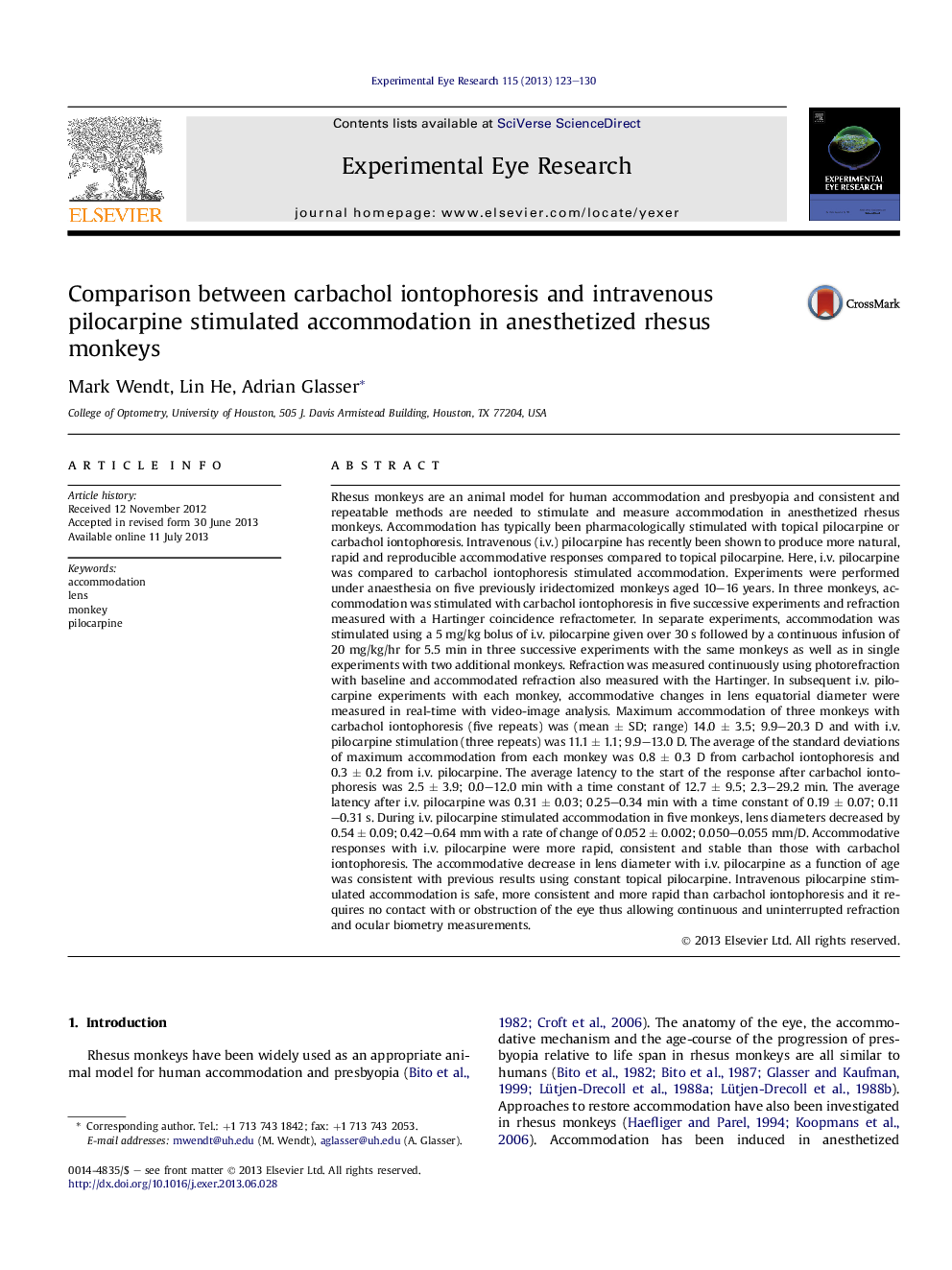| کد مقاله | کد نشریه | سال انتشار | مقاله انگلیسی | نسخه تمام متن |
|---|---|---|---|---|
| 6197112 | 1602607 | 2013 | 8 صفحه PDF | دانلود رایگان |
عنوان انگلیسی مقاله ISI
Comparison between carbachol iontophoresis and intravenous pilocarpine stimulated accommodation in anesthetized rhesus monkeys
ترجمه فارسی عنوان
مقایسه ایونتوفورز کارباکول و محلول تحریک شده داخل وریدی پیلوکارپین در میمونهای رسیوس بیهوشی
دانلود مقاله + سفارش ترجمه
دانلود مقاله ISI انگلیسی
رایگان برای ایرانیان
موضوعات مرتبط
علوم زیستی و بیوفناوری
ایمنی شناسی و میکروب شناسی
ایمونولوژی و میکروب شناسی (عمومی)
چکیده انگلیسی
Rhesus monkeys are an animal model for human accommodation and presbyopia and consistent and repeatable methods are needed to stimulate and measure accommodation in anesthetized rhesus monkeys. Accommodation has typically been pharmacologically stimulated with topical pilocarpine or carbachol iontophoresis. Intravenous (i.v.) pilocarpine has recently been shown to produce more natural, rapid and reproducible accommodative responses compared to topical pilocarpine. Here, i.v. pilocarpine was compared to carbachol iontophoresis stimulated accommodation. Experiments were performed under anaesthesia on five previously iridectomized monkeys aged 10-16 years. In three monkeys, accommodation was stimulated with carbachol iontophoresis in five successive experiments and refraction measured with a Hartinger coincidence refractometer. In separate experiments, accommodation was stimulated using a 5 mg/kg bolus of i.v. pilocarpine given over 30 s followed by a continuous infusion of 20 mg/kg/hr for 5.5 min in three successive experiments with the same monkeys as well as in single experiments with two additional monkeys. Refraction was measured continuously using photorefraction with baseline and accommodated refraction also measured with the Hartinger. In subsequent i.v. pilocarpine experiments with each monkey, accommodative changes in lens equatorial diameter were measured in real-time with video-image analysis. Maximum accommodation of three monkeys with carbachol iontophoresis (five repeats) was (mean ± SD; range) 14.0 ± 3.5; 9.9-20.3 D and with i.v. pilocarpine stimulation (three repeats) was 11.1 ± 1.1; 9.9-13.0 D. The average of the standard deviations of maximum accommodation from each monkey was 0.8 ± 0.3 D from carbachol iontophoresis and 0.3 ± 0.2 from i.v. pilocarpine. The average latency to the start of the response after carbachol iontophoresis was 2.5 ± 3.9; 0.0-12.0 min with a time constant of 12.7 ± 9.5; 2.3-29.2 min. The average latency after i.v. pilocarpine was 0.31 ± 0.03; 0.25-0.34 min with a time constant of 0.19 ± 0.07; 0.11-0.31 s. During i.v. pilocarpine stimulated accommodation in five monkeys, lens diameters decreased by 0.54 ± 0.09; 0.42-0.64 mm with a rate of change of 0.052 ± 0.002; 0.050-0.055 mm/D. Accommodative responses with i.v. pilocarpine were more rapid, consistent and stable than those with carbachol iontophoresis. The accommodative decrease in lens diameter with i.v. pilocarpine as a function of age was consistent with previous results using constant topical pilocarpine. Intravenous pilocarpine stimulated accommodation is safe, more consistent and more rapid than carbachol iontophoresis and it requires no contact with or obstruction of the eye thus allowing continuous and uninterrupted refraction and ocular biometry measurements.
ناشر
Database: Elsevier - ScienceDirect (ساینس دایرکت)
Journal: Experimental Eye Research - Volume 115, October 2013, Pages 123-130
Journal: Experimental Eye Research - Volume 115, October 2013, Pages 123-130
نویسندگان
Mark Wendt, Lin He, Adrian Glasser,
